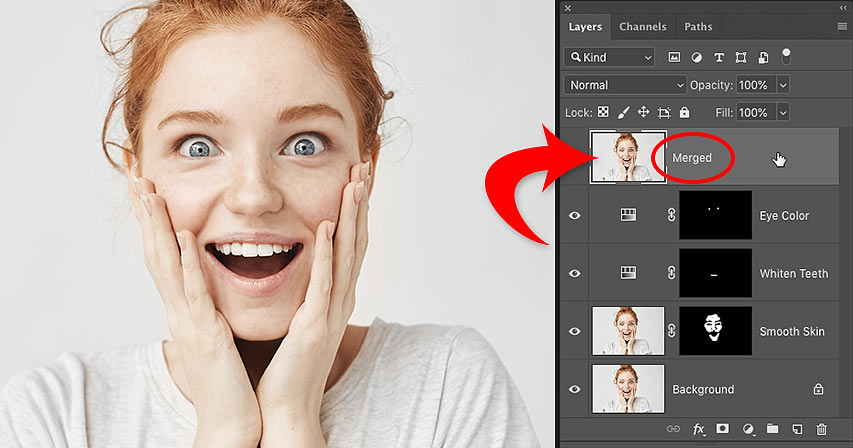Preserving Depth: A Comprehensive Guide on Merging Layers in Photoshop Without Flattening Your Image

Introduction:
Adobe Photoshop, a playground for digital artists and designers, provides a rich canvas for creative expression. As projects evolve, the need to streamline and organize layers arises, often leading users to consider merging layers. However, the traditional approach of flattening an image can be limiting and irreversible. In this exhaustive guide, we will explore advanced techniques on how to merge layers in Photoshop without flattening your image. From understanding layer types to mastering non-destructive merging, this tutorial aims to empower users to maintain flexibility and control while optimizing their layer workflow.
Section 1: Navigating the Layer Landscape
- Introduction to Layer Types:
- Provide an overview of the various layer types in Photoshop, including adjustment layers, text layers, and raster layers. Emphasize the distinct properties and purposes of each layer type.
- Understanding Layer Hierarchies:
- Explore the concept of layer hierarchies and how they contribute to the overall organization of a Photoshop project. Discuss the significance of maintaining a structured layer order.
Section 2: The Traditional Approach: Flattening vs. Merging
- Flattening an Image:
- Discuss the conventional method of flattening an image and its implications. Highlight the irreversible nature of flattening and the loss of individual layer information.
- Merging Layers:
- Introduce the basic techniques for merging layers in Photoshop. Cover the options such as Merge Down, Merge Visible, and Merge Layers, providing step-by-step instructions for each.
Section 3: Challenges with Traditional Merging
- Loss of Flexibility:
- Discuss the challenges associated with traditional merging, including the loss of flexibility for future edits. Emphasize scenarios where maintaining layer independence is crucial.
- Handling Layer Styles and Blending Modes:
- Explore the complications that arise when merging layers with distinct styles and blending modes. Provide insights into preserving these attributes during the merging process.
Section 4: Non-Destructive Merging Techniques
- Smart Objects for Dynamic Merging:
- Introduce Smart Objects as a powerful tool for non-destructive merging. Illustrate how converting layers to Smart Objects preserves their individual properties.
- Using Adjustment Layers and Masks:
- Showcase techniques involving adjustment layers and masks for merging layers while retaining flexibility. Discuss how adjustment layers can be applied to multiple layers simultaneously.
Section 5: Mastering Advanced Merging Techniques
- Grouping Layers for Organization:
- Explore the benefits of grouping layers as an organizational technique. Discuss how grouping maintains layer independence while providing a structured hierarchy.
- Merging Visible Layers with Smart Filters:
- Illustrate the use of Smart Filters in combination with the Merge Visible command. Discuss how this technique enables non-destructive merging with the added benefit of filter re-editability.
Section 6: Merging Text Layers and Vector Shapes
- Preserving Editable Text Layers:
- Address the challenges associated with merging text layers and explore techniques for preserving text editability. Discuss the importance of maintaining vector qualities in text layers.
- Maintaining Vector Shape Properties:
- Showcase methods for merging layers containing vector shapes without losing their properties. Discuss scenarios where preserving vector qualities is essential for scalability and flexibility.
Section 7: Techniques for Complex Projects
- Merging Layers in Grouped Structures:
- Explore techniques for merging layers within grouped structures. Discuss how this approach enhances organization and maintains hierarchy, especially in complex projects.
- Preserving Layer Styles and Effects:
- Delve into strategies for preserving layer styles and effects during the merging process. Discuss the use of adjustment layers and blending options to maintain visual aesthetics.
Section 8: Non-Destructive Editing with Smart Filters
- Converting Layers to Smart Objects:
- Reinforce the importance of converting layers to Smart Objects for non-destructive editing. Discuss how this approach allows for re-editing filters and adjustments even after merging.
- Dynamic Linking with External Smart Objects:
- Introduce the concept of dynamic linking with external Smart Objects. Discuss how linking Smart Objects across multiple documents facilitates synchronized editing.
Section 9: Troubleshooting Common Issues
- Addressing Pixelation and Quality Loss:
- Provide solutions for addressing pixelation and quality loss that may occur during merging. Discuss techniques to maintain image clarity and prevent degradation.
- Handling Layer Overlaps and Transparency:
- Discuss strategies for handling layer overlaps and transparency issues during merging. Provide insights into preserving transparency for elements like shadows and overlays.
Section 10: Future Trends in Layer Management
- Adobe’s Commitment to Layer Flexibility:
- Explore Adobe’s commitment to enhancing layer flexibility in future Photoshop updates. Highlight any official statements, updates, or considerations from Adobe regarding layer management.
- User-Driven Innovation in Layer Workflows:
- Discuss the role of user feedback in shaping the future of Photoshop’s layer workflows. Encourage users to actively engage in discussions, contribute insights, and provide feedback for continuous improvement.
Section 11: Conclusion and Empowered Layer Editing
- Summary of Key Strategies:
- Summarize the key strategies and methods discussed in the guide for merging layers in Photoshop without flattening your image.
- Continuing the Photoshop Journey:
- Inspire users to explore the expansive world of Photoshop features and layer techniques beyond merging. Provide guidance on where to find additional resources and tutorials to further enhance their layer editing skills.
By the end of this extensive guide, users will possess a comprehensive understanding of advanced layer merging techniques in Photoshop, allowing them to streamline their workflows while preserving the depth and flexibility of their creative projects. Armed with these non-destructive merging strategies, users can navigate complex layer structures with confidence, ensuring that each edit contributes to the refinement of their digital masterpieces.







